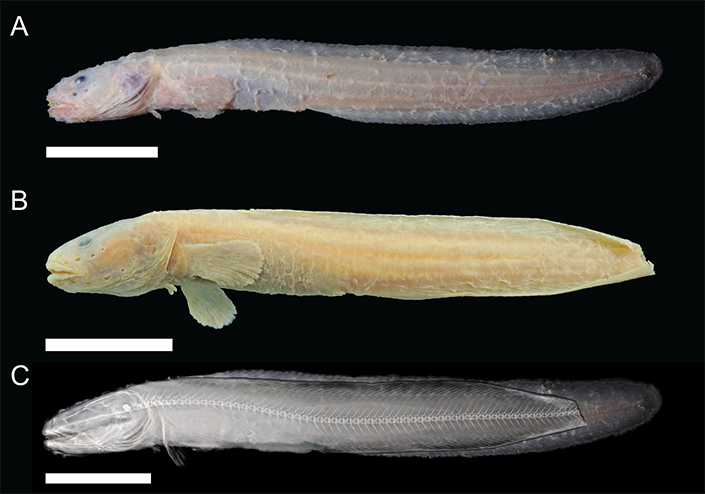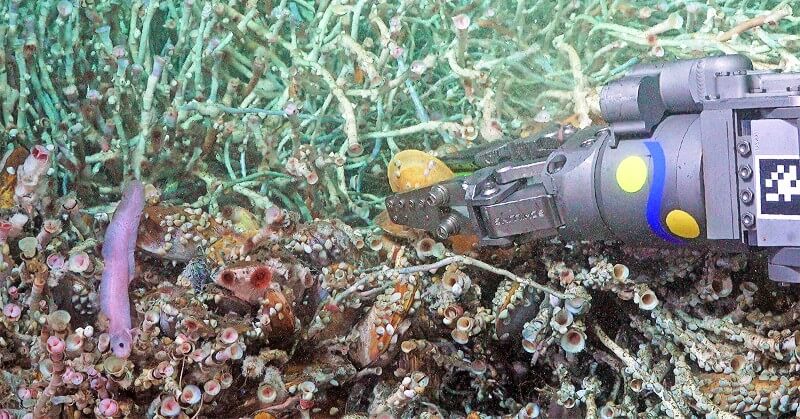A team of researchers led by UC San Diego’s Scripps Institution of Oceanography has discovered a new species of fish—a member of the eelpout family—that lives in the eastern Pacific Ocean off Costa Rica.
The newly identified species, Pyrolycus jaco, is the first fish species to be described from the hydrothermal seep site known as Jacó Scar, located on the Pacific margin of Costa Rica. Measuring roughly 6 inches long with a light pink to lavender colored body, the small eel-like fish has been observed nestling among tubeworms at depths of 1,750-1,800 meters (5,741-5,906 feet). Researchers describe the new species in a paper published Jan. 19 in the journal Zootaxa.
“It is a very mysterious and unique little fish, so we named it after the unique site and city of Jacó in Costa Rica, giving it the name Pyrolycus jaco,” said lead author Ben Frable, collection manager of the Marine Vertebrate Collection at Scripps Oceanography. “This discovery was made possible thanks to previous expeditions and insights made by Scripps marine scientists over the years, and is a great example of how far collaborative research can go.”
Eelpouts are members of the ray-finned fish family Zoarcidae, and are identified by their distinctive eel-shaped bodies, and in some species, what appears to be a “pouting” expression of the mouth. There are roughly 300 known species of eelpout around the world, including some found right off the coast of California.
With the addition of Pyrolycus jaco, there are now 13 known species of eelpout found worldwide on hydrothermal vents or methane seeps—ecosystems fueled by microbes using chemicals from the Earth’s crust rather than sunlight. At methane seeps, natural gas and other chemicals exit the seafloor at the same cold temperature as the surrounding water. At hydrothermal vents, the chemical-rich water expels dramatically like a geyser, reaching temperatures above 400°C (752°F). The new eelpout species joins only four others that are known to occur on hydrothermal vents in the Pacific Ocean.
Pyrolycus jaco is the first eelpout species to be seen on the Jacó Scar methane seep, an extreme environment that exhibits hydrothermal vent-like characteristics, including elevated temperatures up to 5.2°C (41.4°F), which is several degrees warmer than the surrounding areas in the deep sea. This seemingly small difference appears to make Jacó Scar—unlike neighboring methane seeps—a haven for certain animals that typically live only at hydrothermal vents.
The new species is also easily distinguished from similar species by differences in body proportions, such as shorter head length, and variations in the numbers of bones and sensory pores on its body.
The fish was initially seen by Scripps Oceanography scientists Lisa Levin, Greg Rouse, and colleagues in collaboration with the University of Costa Rica when they first discovered the Jacó Scar site in 2009. Using Woods Hole Oceanographic Institution’s Human Occupied Vehicle (HOV) Alvin, they observed several eelpouts swimming among the tubeworms. Over subsequent research cruises, including high-resolution video by the Schmidt Ocean Institute’s remotely operated vehicle (ROV) SuBastian in 2019, the researchers continued exploring this unique ecosystem and to date have described 24 new invertebrate species from Jacó Scar alone, mostly small worms.
Four eelpout specimens collected by HOV Alvin in 2018 formed the basis of the new paper. Two of the specimens are now housed in the Marine Vertebrate Collection at Scripps Oceanography, one in the University of Costa Rica Ichthyology Collection, and the other is in Copenhagen.

The initial research paper describing Jacó Scar did not identify the fish to the species level of classification, explained Frable, as the focus was mainly to report the existence of this unusual seep-vent ‘hybrid’ ecosystem. Then, in 2021, Scripps Oceanography scientist Charlotte Seid was working on a more detailed species inventory and asked Frable to identify the eelpout. Frable said he was “stumped” at what the species might be, so he contacted Peter Rask Møller, a renowned eelpout expert and curator at the Natural History Museum of Denmark. He immediately recognized it as something new and from the genus Pyrolycus, which means “fire wolf.” Frable, Seid, and Møller then worked with colleague Allison Bronson, a CT-scanning expert at Cal Poly Humboldt, to essentially generate a 3D digital X-ray to examine the skeleton without damaging the specimens.
In the Zootaxa paper, the researchers noted that this new species discovery illustrates the extent of novel biodiversity at the Costa Rica methane seeps.
“This eelpout discovery is just one example of how special this particular ecosystem is, and by extension, other deep-sea ecosystems that we have not even discovered yet,” said Seid, collection manager of the Benthic Invertebrate Collection at Scripps Oceanography. “The Jacó Scar study site is just one place that our group has been visiting for years and we’re still finding so many things to discover. This work highlights the need for further exploration and protection of deep-sea habitats, and the technology that we need to study them properly.”
This study was co-authored by Frable, Seid, Møller, and Bronson. Field operations and genetic analyses were funded by several National Science Foundation grants: OCE-0826254, OCE-0939557, OCE-1634172, and OCE-1635219; and the Schmidt Ocean Institute.

